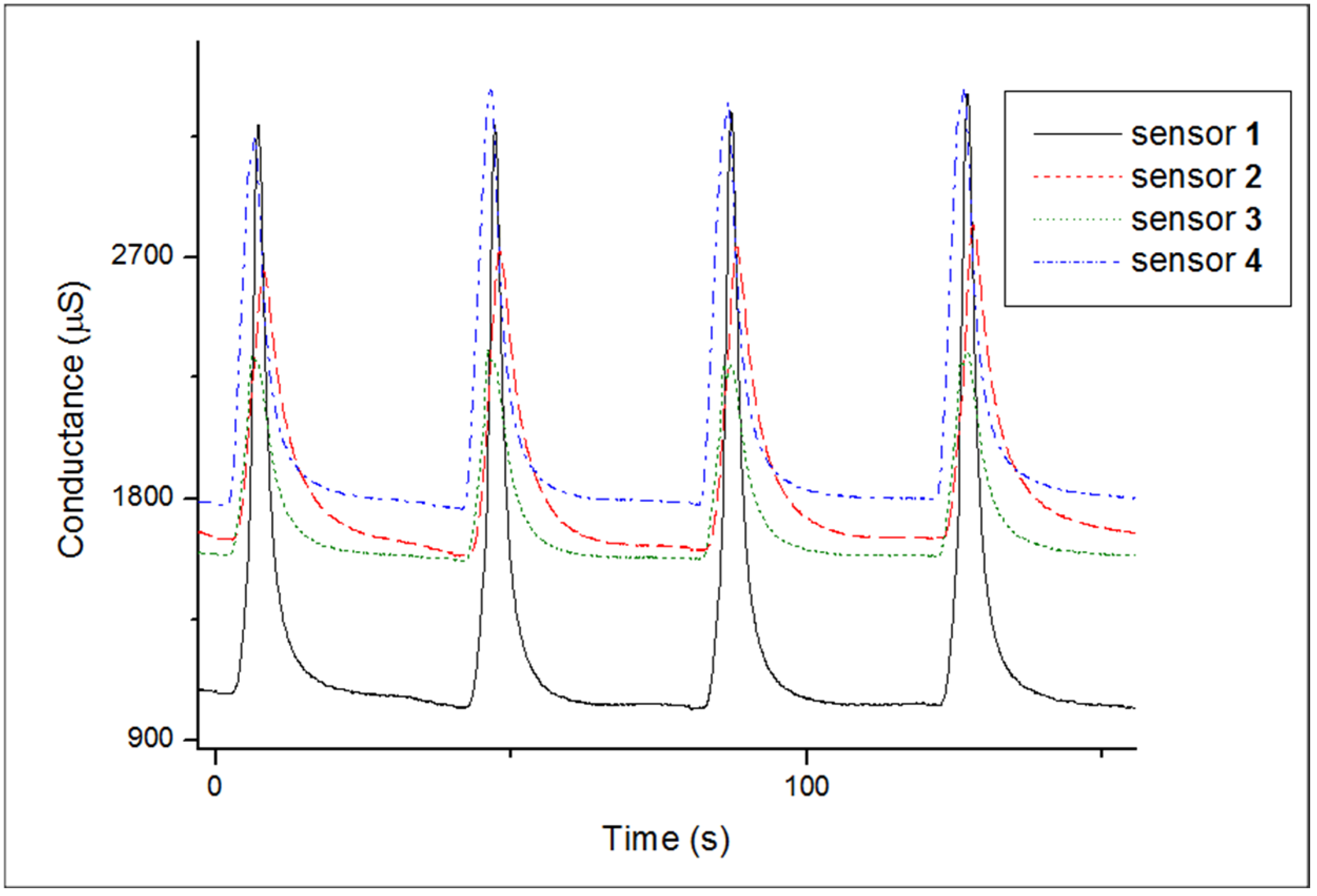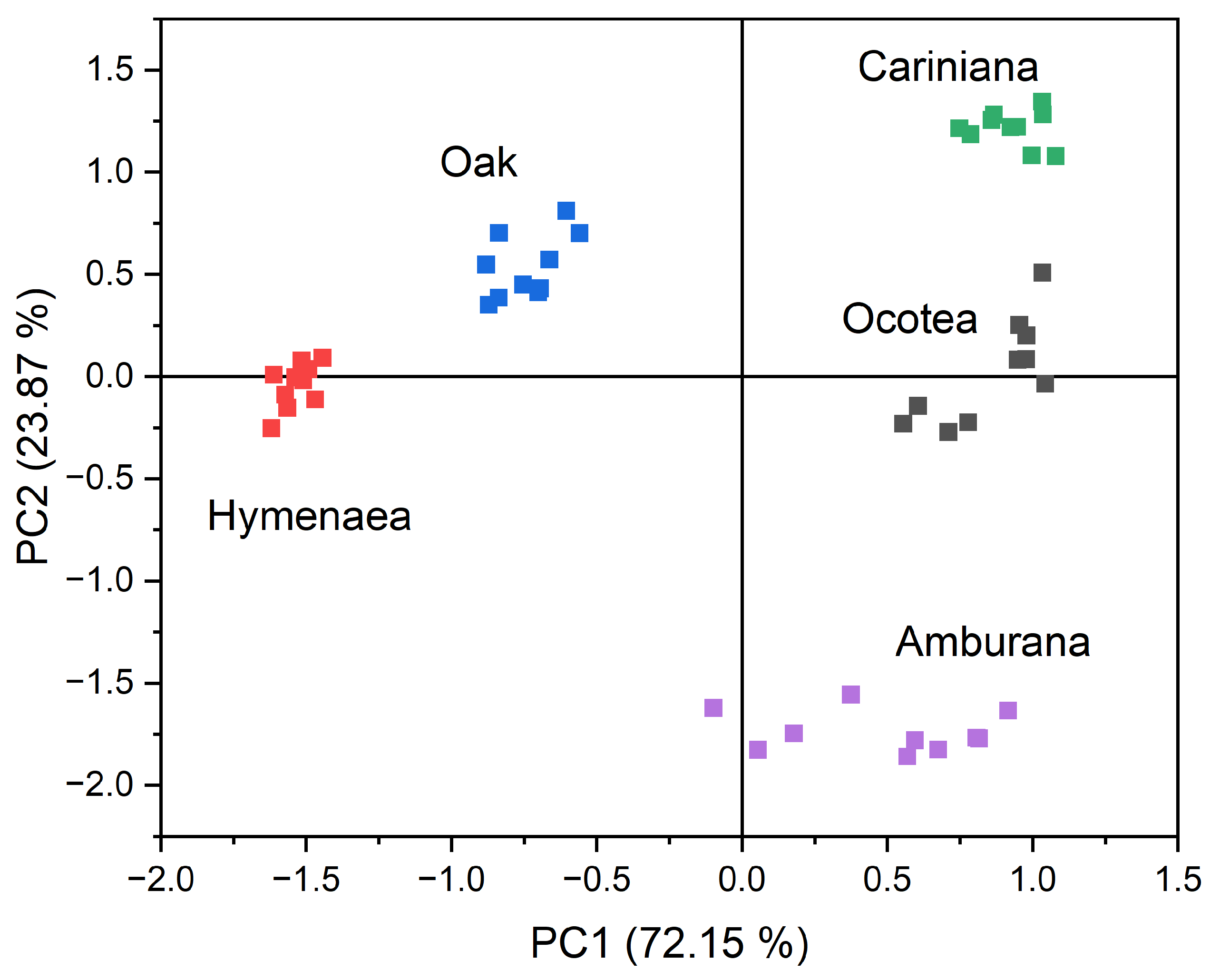Low-Cost Electronic Nose for Identification of Wood Species in Which Brazilian Sugar Cane Spirit Was Aged
Abstract
1. Introduction
2. Materials and Methods
2.1. General Methods
2.2. Conductive Polymers Size Exclusion Chromatography
2.3. Preparation of the Sensors
2.4. Cachaça and Wood Samples
2.5. E-Nose Measurements
3. Results and Discussion
3.1. Syntheses
3.2. E-Nose
4. Conclusions
Author Contributions
Funding
Institutional Review Board Statement
Informed Consent Statement
Data Availability Statement
Acknowledgments
Conflicts of Interest
Abbreviations
| AC | Alternating current |
| CV | Cyclic voltammetry |
| DBSA | Dodecylbenzenesulfonic acid |
| DMF | N,N-dimethylformamide |
| FT | Fourier-transform |
| FTIR | Fourier-transform infrared |
| HPLC/DAD | High-performance liquid chromatography with diode-array detection |
| IAWA | International Association of Wood Anatomists |
| NBS | N-bromosuccinimide |
| NMR | Nuclear magnetic resonance |
| PC | Principal component |
| PCA | Principal component analysis |
| PPX | Poly-p-xylylene |
| SCE | Saturated calomel electrode |
| SEC | Size exclusion chromatography |
| THF | Tetrahydrofuran |
| TMS | Tetramethylsilane |
| UV-Vis | Ultraviolet–visible |
References
- Tarko, T.; Krankowski, F.; Duda-Chodak, A. The Impact of Compounds Extracted from Wood on the Quality of Alcoholic Beverages. Molecules 2023, 28, 620. [Google Scholar] [CrossRef] [PubMed]
- Martínez-Gil, A.; del Alamo-Sanza, M.; Sánchez-Gómez, R.; Nevares, I. Different Woods in Cooperage for Oenology: A Review. Beverages 2018, 4, 94. [Google Scholar] [CrossRef]
- Reazin, G.H. Chemical analysis of whisky maturation. In Flavour of Distilled Beverages: Origin and Development; Piggott, J.R., Ed.; Ellis Horwood: Chichester, UK, 1983; pp. 225–240. [Google Scholar]
- García-Moreno, M.V.; Sánchez-Guillén, M.M.; de Mier, M.R.; Delgado-González, M.J.; Rodríguez-Dodero, M.C.; García-Barroso, C.; Guillén-Sánchez, D.A. Use of Alternative Wood for the Ageing of Brandy de Jerez. Foods 2020, 9, 250. [Google Scholar] [CrossRef] [PubMed]
- Lima, C.M.G.; Benoso, P.; Pierezan, M.D.; Santana, R.F.; Hassemer, G.S.; Rocha, R.A.; Nora, F.M.D.; Verruck, S.; Caetano, D.; Simal-Gandara, J. A state-of-the-art review of the chemical composition of sugarcane spirits and current advances in quality control. J. Food Compos. Anal. 2022, 106, 104338. [Google Scholar] [CrossRef]
- Machado, J.S.; Pereira, F.; Quilhó, T. Assessment of old timber members: Importance of wood species identification and direct tensile test information. Constr. Build. Mater. 2019, 207, 651–660. [Google Scholar] [CrossRef]
- Ruffinatto, F.; Crivellaro, A.; Wiedenhoeft, A.C. Review of Macroscopic Features for Hardwood and Softwood Identification and a Proposal for a New Character List. IAWA J. 2015, 36, 208–241. [Google Scholar] [CrossRef]
- Wheeler, E.A.; Baas, P.; Gasson, P.E. (Eds.) IAWA List of Microscopic Features for Hardwood Identification; International Association of Wood Anatomists: Leiden, the Netherlands, 1989; Volume 10, pp. 219–332. [Google Scholar]
- Zielinski, K.M.; Scabini, L.; Ribas, L.C.; da Silva, N.R.; Beeckman, H.; Verwaeren, J.; Bruno, O.M.; De Baets, B. Advanced wood species identification based on multiple anatomical sections and using deep feature transfer and fusion. Comput. Electron. Agr. 2025, 231, 109867. [Google Scholar] [CrossRef]
- Dierickx, S.; Genbrugge, S.; Beeckman, H.; Hubau, W.; Kibleur, P.; Van den Bulcke, J. Non-destructive wood identification using X-ray μCT scanning: Which resolution do we need? Plant Methods 2024, 20, 1–14. [Google Scholar] [CrossRef]
- Da Silva, A.A.; De Keukeleire, D.; Cardoso, D.R.; Franco, D.W. Multivariate analyses of UV-Vis absorption spectral data from cachaça wood extracts: A model to classify aged Brazilian cachaças according to the wood species used. Anal. Methods 2012, 4, 642–646. [Google Scholar] [CrossRef]
- de Sousa Fernandes, D.D.; de Almeida, V.E.; Fontes, M.M.; de Araújo, M.C.U.; Véras, G.; Diniz, P.H.G.D. Simultaneous identification of the wood types in aged cachaças and their adulterations with wood extracts using digital images and SPA-LDA. Food Chem. 2019, 273, 77–84. [Google Scholar] [CrossRef]
- Rodrigues, B.; Costa, R.M.; Salvini, R.; Soares, A.S.; Silva, F.; Caliari, M.; Cardoso, K.R.; Ribeiro, T. Cachaça classification using chemical features and computer vision. Procedia Comput. Sci. 2014, 29, 2024–2033. [Google Scholar] [CrossRef]
- Silveira, A.L.; Barbeira, P.J.S. A fast and low-cost approach for the discrimination of commercial aged cachaças using synchronous fluorescence spectroscopy and multivariate classification. J. Sci. Food Agric. 2022, 102, 4918–4926. [Google Scholar] [CrossRef] [PubMed]
- Oliveira, S.C.; Oldoni, T.L.C.; Veras, G.; Sousa, E.S.; Fernandes, D.D.S. Non-destructive authentication of Cachaças from Breno Paraibano based on MIR spectroscopy. Food Chem. 2025, 477, 143554. [Google Scholar] [CrossRef] [PubMed]
- Sivello, G.C.; Alcarde, A.R. Experimental design and chemometric techniques applied in electronic nose analysis of wood-aged sugar cane spirit (cachaça). J. Agr. Food Res. 2020, 2, 100037. [Google Scholar]
- Matrí, M.P.; Pino, J.; Boqué, R.; Busto, O.; Giasch, J. Determination of ageing time of spirits in oak barrels using a headspace–mass spectrometry (HS-MS) electronic nose system and multivariate calibration. Anal. Bioanal. Chem. 2005, 382, 440–443. [Google Scholar]
- Chiu, S.-W.; Tang, K.-T. Towards a Chemiresistive Sensor-Integrated Electronic Nose: A Review. Sensors 2013, 13, 14214–14247. [Google Scholar] [CrossRef]
- Niinomi, T.; Nakao, A.; Hanai, Y.; Ushio, H.; Hayashi, T.; Nakatani, M. A Compact 16-Channel Input Thermally Adsorption-/Desorption-Controlled Intelligent Odor Sensing System. IEEE Sens. J. 2024, 24, 9334–9340. [Google Scholar] [CrossRef]
- Esteves, H.A.; Gonçalves, W.B.; Teixeira, W.S.R.; Pádua, A.C.C.S.; Gruber, J. Conductive polymer-based sensors. In Organic and Inorganic Materials Based Sensors, 1st ed.; Das, S., Thomas, S., Das, P., Eds.; Wiley: Weinheim, Germany, 2024; Volume 2, pp. 559–591. [Google Scholar]
- Li, R.W.C.; Carvalho, L.R.F.; Ventura, L.; Gruber, J. low cost selective sensor for carbonyl compounds in air based on a novel conductive poly(p-xylylene) derivative. Mater. Sci. Eng. C 2009, 29, 426–429. [Google Scholar] [CrossRef]
- Li, R.W.C.; Ventura, L.; Gruber, J.; Kawano, Y.; Carvalho, L.R.F. A selective conductive polymer-based sensor for volatile halogenated organic compounds (VHOC). Sens. Actuators B Chem. 2008, 131, 646–651. [Google Scholar] [CrossRef]
- Rocha, R.T.; Gutz, I.G.R.; Lago, C.L. A Low-Cost and High-Performance Conductivity Meter. J. Chem. Educ. 1997, 74, 572–574. [Google Scholar] [CrossRef]
- Lopes, F.M.; Martins, D.C.; Cesar, R.M. Feature selection environment for genomic applications. BMC Bioinform. 2008, 9, 451. [Google Scholar] [CrossRef] [PubMed]
- Pomerantsev, A.L.; Rodionova, O.Y. Procrustes Cross-Validation of short datasets in PCA context. Talanta 2021, 226, 122104. [Google Scholar] [CrossRef] [PubMed]
- Flamini, R.; Vedova, A.D.; Cancian, D.; Panighel, A.; De Rosso, M. GC/MS-positive ion chemical ionization and MS/MS study of volatile benzene compounds in five different woods used in barrel making. J. Mass Spectrom. 2007, 42, 641–646. [Google Scholar] [CrossRef] [PubMed]






Disclaimer/Publisher’s Note: The statements, opinions and data contained in all publications are solely those of the individual author(s) and contributor(s) and not of MDPI and/or the editor(s). MDPI and/or the editor(s) disclaim responsibility for any injury to people or property resulting from any ideas, methods, instructions or products referred to in the content. |
© 2025 by the authors. Licensee MDPI, Basel, Switzerland. This article is an open access article distributed under the terms and conditions of the Creative Commons Attribution (CC BY) license (https://creativecommons.org/licenses/by/4.0/).
Share and Cite
da Silva, A.A.; Vieira, B.R.; Yamauchi, E.Y.; Li, R.W.C.; Gruber, J. Low-Cost Electronic Nose for Identification of Wood Species in Which Brazilian Sugar Cane Spirit Was Aged. Chemosensors 2025, 13, 172. https://doi.org/10.3390/chemosensors13050172
da Silva AA, Vieira BR, Yamauchi EY, Li RWC, Gruber J. Low-Cost Electronic Nose for Identification of Wood Species in Which Brazilian Sugar Cane Spirit Was Aged. Chemosensors. 2025; 13(5):172. https://doi.org/10.3390/chemosensors13050172
Chicago/Turabian Styleda Silva, Alexandre A., Bruna R. Vieira, Elaine Y. Yamauchi, Rosamaria W. C. Li, and Jonas Gruber. 2025. "Low-Cost Electronic Nose for Identification of Wood Species in Which Brazilian Sugar Cane Spirit Was Aged" Chemosensors 13, no. 5: 172. https://doi.org/10.3390/chemosensors13050172
APA Styleda Silva, A. A., Vieira, B. R., Yamauchi, E. Y., Li, R. W. C., & Gruber, J. (2025). Low-Cost Electronic Nose for Identification of Wood Species in Which Brazilian Sugar Cane Spirit Was Aged. Chemosensors, 13(5), 172. https://doi.org/10.3390/chemosensors13050172






